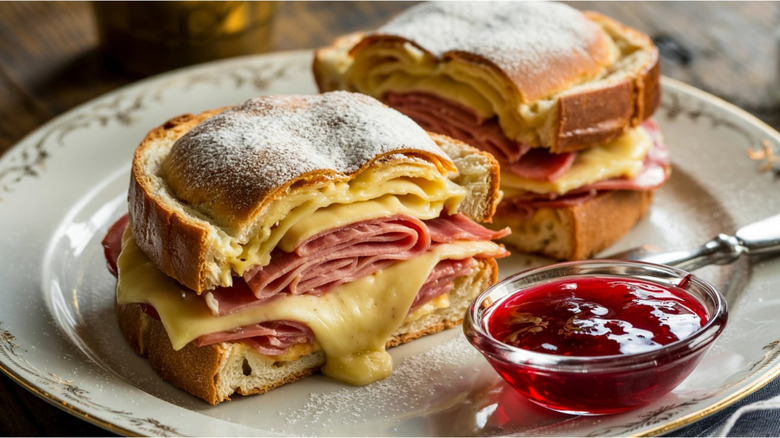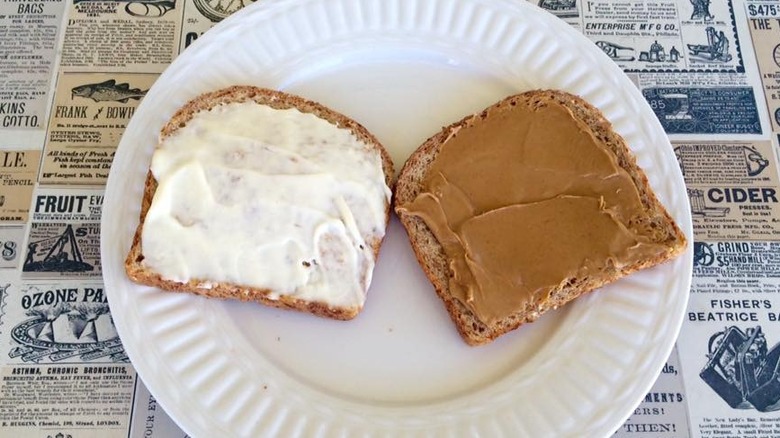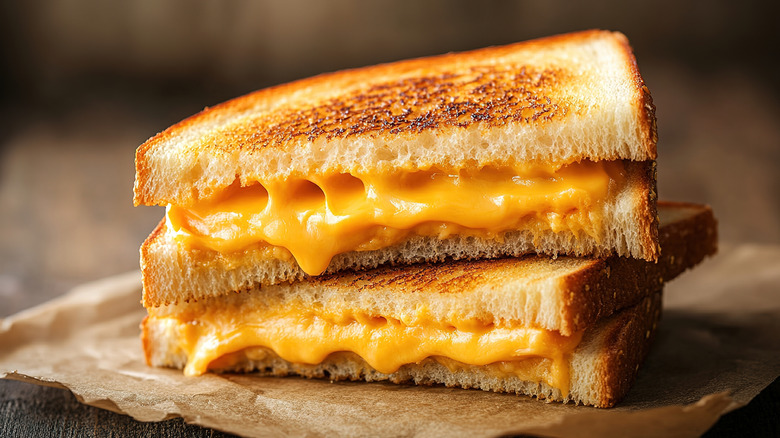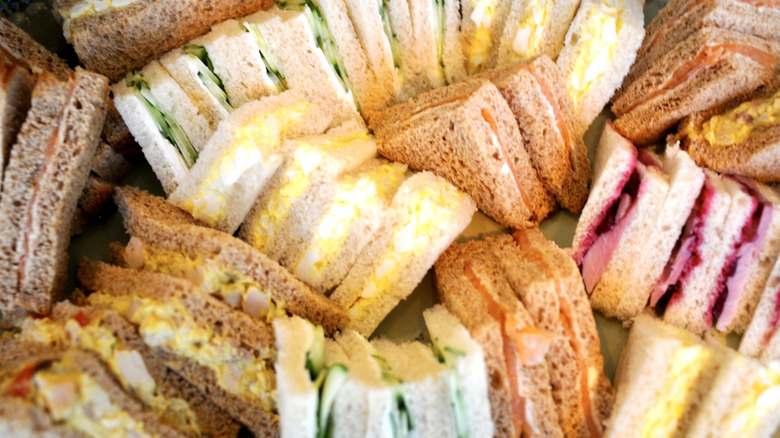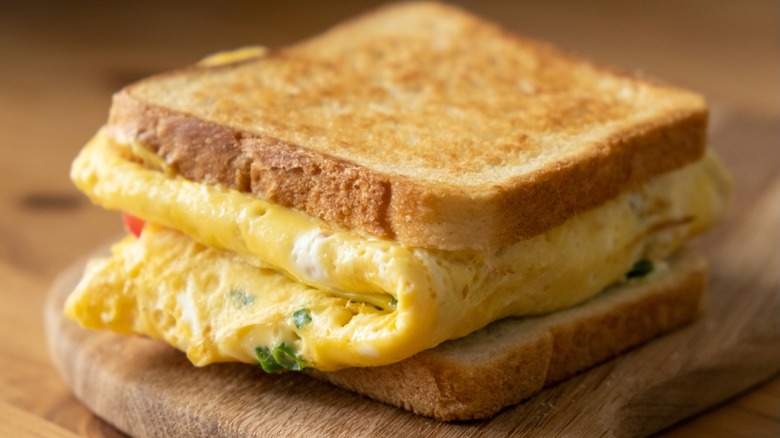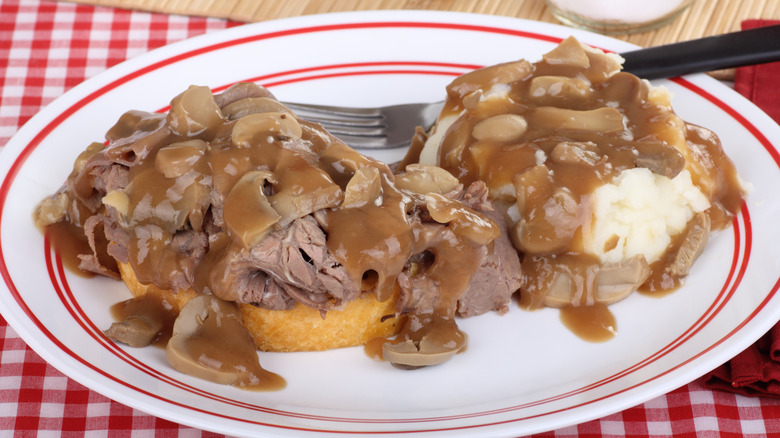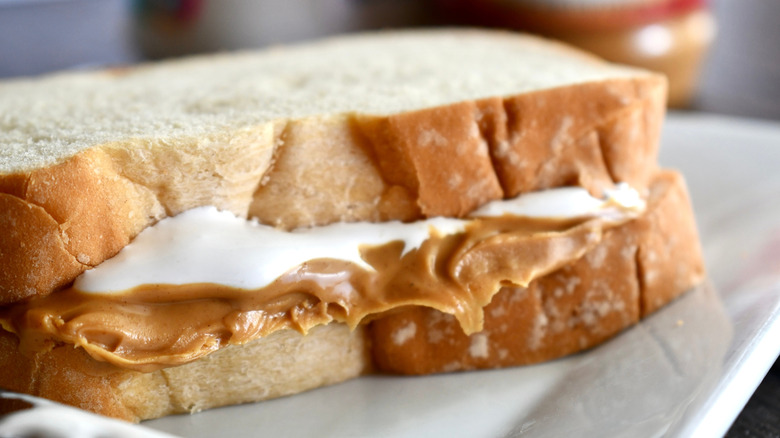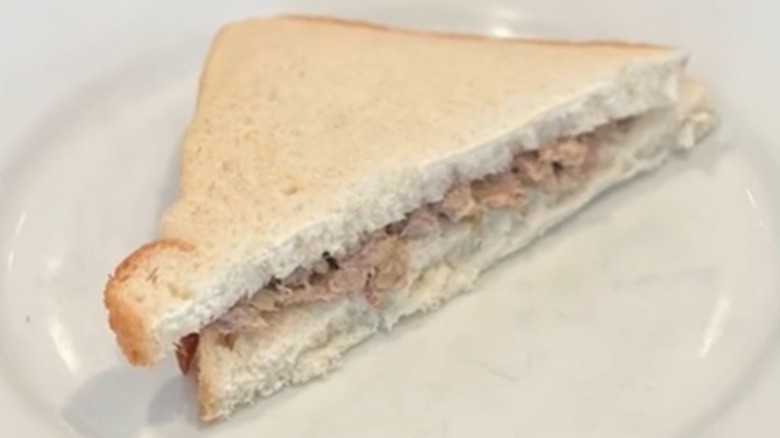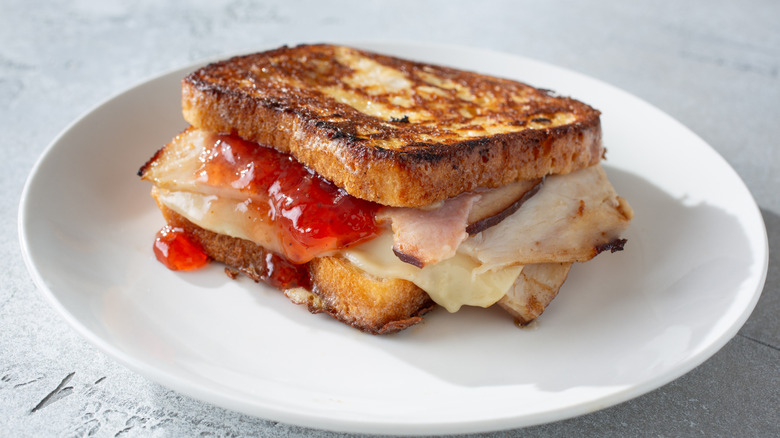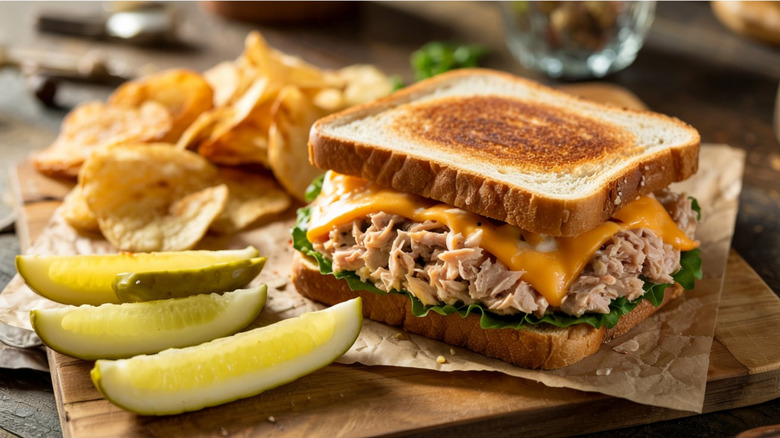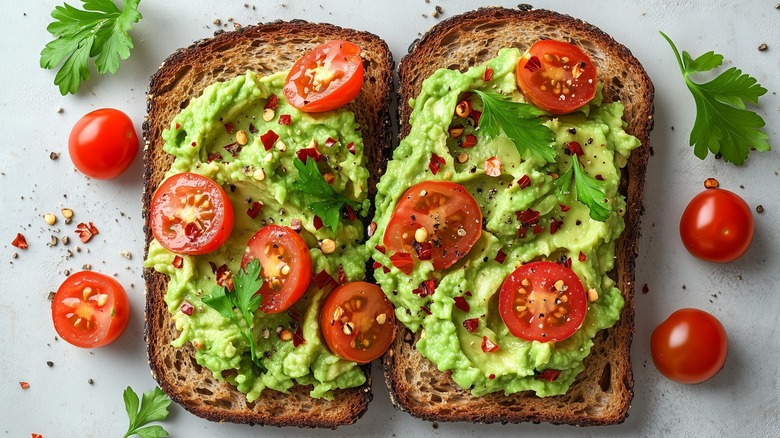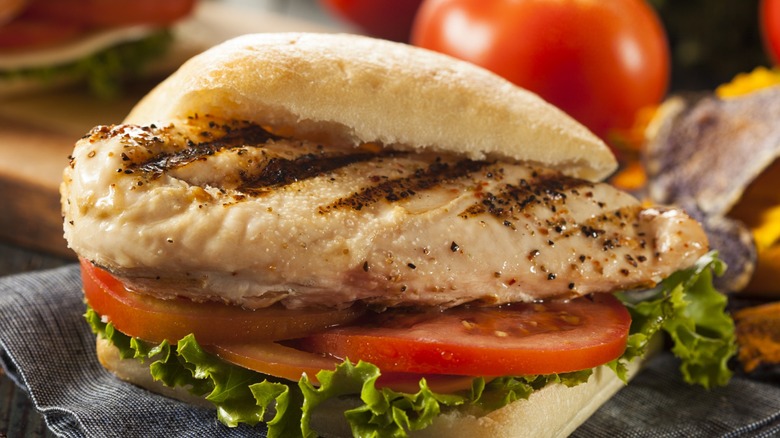11 Popular Sandwiches From The 1960s
Few food folk could argue that the sandwich is one of the most versatile creations ever conjured up in the kitchen. The possibilities for breads and fillings are essentially endless, shifting from the sweet and savory mix of jams, jellies, and nut butters to the hearty deli plans that bring meat, cheese, and vegetables into a single handheld meal. You could make a sandwich for lunch every day for a year and still not work your way through the entire collection of vintage sandwiches with nostalgic diner-counter charm.
The mid-20th century in particular was a heyday for sandwich makers and short-order cooks, with the 1960s showing off a vibrantly active period of sandwich inspiration. Many of these clever combinations faded quicker than beehive hair and fringed vests, becoming faint memories of yesteryear as newer and more exciting creations took their places. Others stood out as timeless treasures and are still enjoyed by sandwich fans to this day. Wouldn't it be fun to take a backward glance and see which popular sandwiches from the 1960s were destined for greatness and which didn't make it into the 1970s, let alone the new millennium? It sure would!
1. Peanut butter and mayonnaise
Peanut butter on a sandwich is hunky-dory, and a plain mayonnaise sandwich can be a simple bite, but a tasty one nonetheless. When you combine these two savory spreads, you get the peanut butter and mayonnaise sandwich, which had all the groovy kids in the 1960s crying out for more. Anyone with an affiliation to the Southern United States undoubtedly has stories of relatives who indulged in the affordable peanut butter and mayonnaise sandwich in days gone by — and who likely hold onto this popular 1960s sandwich styling as a retro treat. The unusual combination of tangy and creamy toppings that usually did their own thing found common ground in a creation that added colorful character to otherwise bland lunch bags and dinner plates.
It may be hard to believe, but this mushy mash-up was once as popular as PB&J. While that classic combination is destined for the all-time sandwich hall of fame thanks to its simplicity and enduring enjoyment, the peanut butter and mayonnaise sandwich didn't quite make it out of the 1960s as anything more than a novelty with a Facebook page where lovers of this strange snack recreate the experience and take photos to commemorate the moment. With the most recent post dated 2018, interest in a PB&M seems to have waned yet again.
2. Grilled cheese
There are plenty of ways to upgrade a grilled cheese sandwich and make it something more spectacular. But even in its simple form, this timeless treasure of the kitchen was one of the most popular sandwiches of the 1960s, though it's a slightly different shape than it had in previous decades. It was in the decade of Day-Glo and minidresses that a particular chef had the inspired notion to add a second piece of bread to an open face toasted cheese sandwich, giving rise to the grilled cheese sandwich we've all come to know and love in the modern age. What was once loved as toasted cheese became heartier, sturdier, and easier to dip into a bowl of tomato soup. Genius!
American, cheddar, and Swiss were the cheeses most often used to create the melty center as the sandwich gained favor in the 1960s, though more creative home chefs have utilized cheeses of all sorts and styles through the years. Some intrepid soul decided to incorporate tomato slices along the way as well, though the result is something less pure and directly pleasurable than what the original offers. Now, the simple original format allows variations and upgrades that made grilled cheese sandwiches into something even more special. If you're imagining the bread crunching and the cheese pulling apart in never-ending strings from your own experiences with the magnificent grilled cheese sandwich, you have the 1960s to thank for it.
3. Finger sandwiches
Unless you attend an afternoon tea or have money to burn in your family mansion, you may never have had the experience of dining on finger sandwiches. But these slim vittles where all the rage in the 1960s, when home entertaining was more in vogue and impressing your guests with upscale sandwiches was something to fret over. Anytime this slimmed-down sandwich is mentioned in the modern age, it conjures a misty nostalgia, visions of a time when eating a whole sandwich was gauche and cut an inelegant figure when laid on a platter.
Finger sandwiches are generally miniature versions of full-size sandwiches with the crusts removed, cut down to be a tidier bite than a larger sandwich might be. They come filled with lighter spreads like cucumber and cream cheese or jelly and butter, and they usually present as geometrically precise rectangles or triangles that make a pretty presentation for a teatime spread. If you've ever sliced the crust off of your peanut butter and jelly sandwich, you've come very close to experiencing your own finger sandwich without even knowing it. Who knew partaking of a popular 1960s sandwich was so easy?
4. Omelet sandwiches
The advent of the McDonald's Egg McMuffin made egg-based sandwiches fast and easy to acquire, but before they became a drive-thru sensation, they showed up in the 1960s as the omelet sandwich. It's a chameleon of a handheld breakfast bite that appears in other forms in the contemporary sandwich fan's lexicon, sometimes as an egg roll, other times as a scrambled egg sandwich. But always, this midcentury concoction separates itself from that other egg-based sandwich, egg salad, by featuring eggs that haven't been hardboiled, but instead cooked in a pan or on a griddle and left in more breakfast-ready shape. The result is an invention that captures the whole sunrise platter in a single swoop of toasty, eggy goodness.
In its most straightforward form, an omelet sandwich consisted simply of fluffy eggs seasoned with salt and pepper, then put in either toast or soft bread. More deluxe options range from adding cheese to the eggs to tossing in ham, peppers, onions, and all sorts of other omelet-ready elements and serving it up on everything from a brioche roll to a bagel to ciabatta bread. Beyond giving the 1960s a signature sandwich that feels more like a deli make-and-take order, the omelet sandwich allowed diners to enjoy both their eggs and their toast as a unified dish that kept convenience front-of-mind. In fact, it's still enjoyed in the modern world and celebrated on social media as a gourmet morsel.
5. Broiled soup sandwiches
If you're not a child of the '60s, it may never have occurred to you to pour soup on top of your sandwich, even if they came in the same lunch counter order. Campbell's Soup Company had the bright idea to merge liquid and solid lunch items into one, creating a campaign for something they called broiled soup sandwiches. The concept seemed to extend the use of gravy over turkey sandwiches and au jus over a French dip as a way for the company to sell more cans of Cream of Mushroom and Tomato. Advertisements displayed photos of popular soups poured over bread and meat in an effort to maximize this odd yet intriguing culinary combination. Photos even include a sliced hot dog on a bun doused in chili, a real stretch for the definition of a sandwich.
While the possibility of having your soup and sandwich served up in one go might have trimmed your diner bill, the prospect of slicing into soggy bread and scooping up the pieces with a spoon seems unnecessarily messy now. It isn't something you find on restaurant menus or home tables these days; if soup and sandwiches pair up for dining delivery, they each stick to their own piece of tableware. Though plenty of people do the dipping thing, you aren't likely to find a broiled soup sandwich this far outside of the 1960s. The closest modern equivalent? An open-faced roast beef sandwich dressed in gravy, which comes pretty close.
6. Fluffernutter
The popular peanut butter and marshmallow cream sandwich had been around since the early 20th century before it turned into a phenomenon with a silly name. It was in 1960 that an ad agency came up with the moniker "fluffernutter" as a fun way to advertise marshmallow crème for a company called Durkee-Mower. Suddenly, it wasn't just a novelty nosh with a name that made sense anymore; it had become a sugary sandwich sensation that matched nomenclature to personality and whipped the sandwich eating public into a frenzy. Though the concept waned in popularity as the decades rolled on, it never fully departed the pantheon of noteworthy sandwiches.
If it's challenging to absorb the concept of a sandwich made with marshmallow goo piled on top of peanut butter, think of it as a homemade Pop Tart without the al dente pastry parts, or a gigantic s'more that invites all sorts of candy-based add-ins like chocolate chips or caramel sauce. Running a fluffernutter under the broiler toasts the bread and possibly the marshmallow fluff if you cook yours with both halves open. You can turn this popular 1960s sandwich into a dessert game changer by using sweeter exteriors like banana or spice bread to give them even more flavor. Describing it now, it's hard to believe more people haven't embraced a fluffernutter resurgence. It's high time to kick off a whole new age for this gooey goody of a sandwich invention.
7. Anchovy paste
Just calling it an anchovy paste sandwich gives the impression that the odd choice of filling is sort of old-fashioned. But once upon a time in the 1960s, literature's most debonaire secret agent turned his fan base onto this peculiar morsel when it was introduced in Ian Fleming's short story "For Your Eyes Only." Of course, it wasn't a new addition to the culinary world; a recipe dating back to the early 1900s proves the mashed fish creation to be a much older invention. But thanks to a character Mrs. Havelock eating a sandwich featuring what is referred to as The Gentleman's Relish (a fancier name for anchovy paste), fans of the super spy latched on to the spread-on-bread and launched a small revolution.
By the time Fleming's intriguing tale joined the other James Bond works as a cinematic feature in 1981, anchovy paste sandwiches had largely gone the way of the dinosaurs. Nowadays, you can give it a spin if you're an adventurous sort who likes a game of sandwich roulette every now and then. All it takes to recreate the original is tinned anchovies in oil mashed to a pulp and seasoned with salt and pepper spread on bread. Adding tomatoes and lettuce to dress up the occasion is also part of the tale and sounds like a surefire way to make the mush more palatable.
8. Monte Cristo
The first time you hear about a Monte Cristo sandwich is bound to be a mind-bending moment that makes an indelible impression. How else could you receive the knowledge that a fried sandwich made with ham, cheese, and grape jelly on buttered toast isn't just someone's ridiculous folly but an actual sandwich loved by daring eaters in the 1960s? It might seem like the combination is too wild to be appealing. But once you bite into the triple-play of sweet, salty, gooey, and crunchy, you discover it's similar to honey-baked ham with a creamy cheese layer that helps make everything OK.
Debates linger about how the name arose, as well as how a proper Monte Cristo is made. Some dip the sandwich in egg batter before frying, a la stuffed French toast. Though the original used Gruyère and slices of ham, turkey, or chicken sweetened with a cup of jelly as a dipping sauce, there are versions that use ham or turkey and Swiss with the jelly used as a spread instead. It had been around for decades as an update to the more familiar French croque monsieur when none other than Disneyland gave it a boost in 1966 by adding it to the park's New Orleans Square restaurants. Now, reintroduction of the sandwich as a specialty item on fast-casual and deli menus in the 2000s gives diners a sense of speakeasy-style cool as they impress their fellow foodies by ordering a tasty throwback.
9. Tuna melt
Take an oversized scoop of tuna with mayonnaise, spread it on buttered bread, lay a piece of cheese on top and give it a sizzle in the frying pan and you have the tuna melt, a sandwich that made diner excursions in the 1960s more exciting. It was the perfect alternative to a patty melt, which put a burger and cheese between two slices of bread instead of a bun, and a selection that let fish fans enjoy something a little snazzier than the same old tuna sandwich they could make at home.
The tuna melt may have inadvertently become a sandwich smash when a Woolworth's cook discovered their tuna had merged with a grilled cheese sandwich, but by the time the 1960s were over, this wild blend was a part of the permanent diner collection. You can find the best tuna melts in the U.S. in diners and family-style restaurants that still honor the classics. And since making your own is as easy as adding a slice of cheese to a tuna sandwich and giving it a little heat in a buttered frying pan, you can experiment with the recipe to come up with your own twist on a simple yet satisfying 1960s gem.
10. Avocado
Hipsters from the 2000s may think they invented the concept of avocado toast. But decades before this persnickety dish became a hot commodity, it had made its debut as a 1960s culinary invention on the California dining circuit. Bucking the trend of healthful eating, the original avocado sandwich featured mayonnaise, butter, or cream cheese to make a mushy situation even mushier — and more decadent. All of this culinary razzmatazz makes this creation sound suspiciously similar to egg salad in both taste and texture.
Thanks to the resurrection of avocados as deluxe dining, avocados weathered future eras by disguising itself as guacamole in the 1970s, a salad mix-in in the 1980s, and a burger topper in the 1990s. Now that the open-faced avocado sandwich reimagined as iconic avocado toast is used by older generations as shorthand for ritzy living — as in "giving up avocado toast can help you buy a house" — the avocado sandwich has demonstrated staying power few foodies from the 1960s could have predicted. If the price of avocados would just come down a little, maybe this beauty can make it into the 2030s in some magical new gourmet form waiting to be invented.
11. Grilled chicken
It's easy to take grilled chicken sandwiches for granted now that they're a staple on fast casual menus everywhere. But they were a hot find when they first winged their way into the consciousness of sandwich minded eaters back in the 1960s. Then, it was a protein packed diet food that could deliver a leaner and cleaner restaurant meal than a classic burger or even a pastrami sandwich. Suddenly, cautious diners had an order they could enjoy without blowing up their fitness regimen. Sure, the bun was high-carb, but without it, the dish was just grilled chicken on a plate, which is nowhere near the same.
Eventually, grilled chicken gave way to fried chicken sandwiches, which cleared a path for pressed chicken patties that took over fast food as a 1980s alternative to the classic burger. By the 1990s, eaters were ready for a lighter version of a chicken sandwich, and grilled chicken sandwiches started showing up on the restaurant scene once again. Though they tend to be more expensive and experience a come-and-go existence on menus depending on which eatery is trying to capture the public's attention at any given time, the grilled chicken sandwich is one 1960s favorite that keeps on keepin' on.
